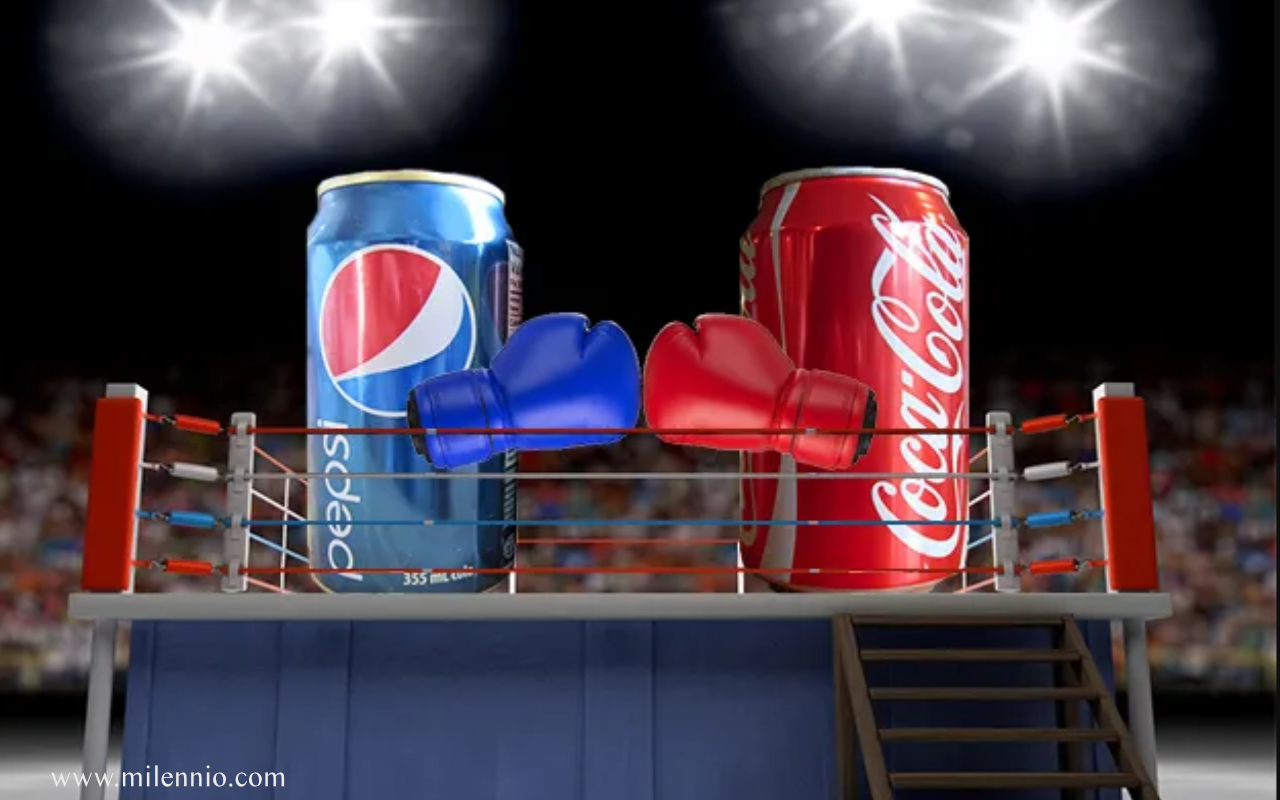Once upon a time in the bustling landscape of American commerce, two titans emerged to battle for the hearts and taste buds of consumers: Coca-Cola and Pepsi. Their rivalry, known as the “Cola Wars,” would not only shape their destinies but also redefine the soft drink industry and consumer culture itself.
The Birth of Rivals
n 1886, a pharmacist named Dr. John Stith Pemberton concocted a fizzy beverage in Atlanta, Georgia, that he believed would cure ailments and invigorate spirits. He named it Coca-Cola. Little did he know, this sweet elixir would grow into a global phenomenon.
Meanwhile, in 1898, Caleb Bradham, another enterprising pharmacist, created a drink he called “Brad’s Drink” in North Carolina. Later rebranded as Pepsi-Cola, this beverage was designed to aid digestion and boost energy. At first, these two drinks coexisted peacefully, unaware that they were destined to become fierce competitors.
The Spark of Competition
The real rivalry ignited in the mid-20th century when Pepsi began to challenge Coca-Cola’s dominance. In 1975, Pepsi launched the groundbreaking “Pepsi Challenge,” a bold blind taste test campaign that claimed consumers preferred its sweeter flavor over Coca-Cola’s classic recipe. The results were staggering: many did prefer Pepsi. This campaign not only boosted Pepsi’s sales but also shook Coca-Cola to its core.
In response to this challenge, Coca-Cola faced a critical decision. In 1985, seeking to reclaim its throne, the company introduced “New Coke,” a reformulated version that aimed to compete directly with Pepsi’s sweetness. However, the move backfired spectacularly. Loyal Coca-Cola fans revolted against the change, leading to a public outcry and a swift return to the original formula. This misstep became a pivotal moment in the saga—one that revitalized interest in Coca-Cola and solidified its place in American culture.
The Battle of Advertising
As the rivalry heated up through the 1990s and into the 2000s, both companies unleashed a barrage of marketing campaigns that were as entertaining as they were competitive. Pepsi took playful jabs at Coca-Cola in its advertisements, often portraying itself as the youthful alternative. Meanwhile, Coca-Cola emphasized its rich heritage and classic status, appealing to nostalgia and tradition.
This fierce competition led to an explosion of creativity in advertising. Super Bowl commercials became battlegrounds where both brands showcased their latest strategies and celebrity endorsements—each trying to outdo the other in capturing consumer attention.
Coca-Cola’s Product Innovations
Coca-Cola has consistently expanded its product line to cater to changing consumer tastes and preferences. Notable innovations include:
- Vanilla Coke: Launched in 2002, it helped Coca-Cola capture a new segment of consumers looking for flavored options. This product contributed to an increase in Coca-Cola’s market share, as it appealed to those seeking variety beyond traditional cola flavors
- Coca-Cola with Coffee: Introduced in 2021, this hybrid beverage combines the classic Coke flavor with coffee, targeting consumers looking for a refreshing pick-me-up. The product quickly gained popularity, with 88% of consumers indicating they would purchase it again, showcasing its success in attracting new customers and increasing sales during traditionally low-demand periods
- Health-Conscious Options: The introduction of Coca-Cola Zero Sugar and Diet Coke has allowed the brand to tap into the growing demand for low-calorie beverages. These products have been instrumental in maintaining Coca-Cola’s stronghold in the market as health trends continue to influence consumer choices
These innovations have not only helped Coca-Cola maintain its dominance but also allowed it to increase its market share over time, particularly against Pepsi.
Pepsi’s Strategic Launches
Pepsi has also made significant strides through product innovation:
- Pepsi MAX: Launched as a zero-calorie alternative that retains the original Pepsi flavor, Pepsi MAX has been a key driver of growth. It appeals particularly to younger consumers, with over 70% preferring it over regular cola options, thus bolstering Pepsi’s market position
- Limited Editions: The introduction of products like Pepsi Electric, a bold blue cola with a citrus flavor, reflects Pepsi’s strategy to attract Generation Z consumers who seek unique and exciting flavors. This approach not only diversifies their offerings but also helps capture attention on store shelves, potentially increasing sales and market share among younger demographics
- Flavor Diversification: Pepsi has expanded its flavor portfolio with offerings such as Mountain Dew Code Red and various fruit-flavored variants. These products have shown strong sales growth and have helped Pepsi maintain competitiveness against Coca-Cola’s extensive lineup
Coca-Cola’s Marketing Visionaries
- Robert Woodruff: As president from 1923 to 1954, Woodruff emphasized global expansion and brand consistency, establishing Coca-Cola as a household name worldwide. His vision included aggressive marketing campaigns that positioned Coke as a refreshing beverage for all occasions.
- Sergio Zyman: As CMO in the 1990s, Zyman revolutionized Coca-Cola’s marketing by focusing on emotional connections with consumers. His campaigns, such as “Always Coca-Cola,” emphasized the brand’s heritage and emotional resonance, helping to reinforce customer loyalty.
- James Quincey: The current CEO has pushed for a more diversified product portfolio and sustainability initiatives, recognizing the need to adapt to changing consumer preferences towards health-conscious options.
Pepsi’s Marketing Innovators
- Caleb Bradham: The founder of Pepsi, Bradham was an early marketing pioneer who positioned his drink as a refreshing tonic. His focus on value during the Great Depression helped establish a loyal customer base.
- Roger Enrico: As CEO in the 1990s, Enrico championed the “Pepsi Challenge,” a blind taste test that directly challenged Coca-Cola’s dominance. This campaign not only boosted sales but also positioned Pepsi as a viable alternative.
- Beyoncé and Other Celebrities: Pepsi’s strategy of leveraging star power has been key to its success. Collaborations with celebrities like Beyoncé and Michael Jackson have created memorable campaigns that resonate with younger audiences and integrate Pepsi into popular culture.
Market Impact
The strategic introduction of new products by both companies has led to several key outcomes:
- Increased Competition: The constant innovation cycle keeps both brands on their toes, leading to aggressive marketing campaigns and promotions that benefit consumers through better choices and pricing.
- Market Share Dynamics: While Coca-Cola has historically commanded a larger share of the market (approximately 50% globally), Pepsi has managed to secure around 20%. New product launches have allowed both companies to gain or maintain market share within specific segments, particularly among health-conscious consumers and younger audiences
- Consumer Loyalty and Brand Identity: Both brands have cultivated strong loyalty through their innovative offerings. Consumers often develop preferences based on flavor diversity and brand identity, which are reinforced through effective marketing strategies
The introduction of new products by Coca-Cola and Pepsi has played a crucial role in shaping their market shares. By continuously adapting to consumer preferences and trends, both companies have managed to sustain their positions as leaders in the soft drink industry while fostering an environment of healthy competition that ultimately benefits consumers
Adapting to Change
As health consciousness began to sweep across America in the late 20th century, both companies recognized the need for change. They expanded their product lines beyond sugary sodas into healthier options like Diet Coke and Pepsi Zero Sugar. They also ventured into non-carbonated beverages such as juices and teas, adapting to shifting consumer preferences.
The global stage became another arena for their rivalry. Coca-Cola established itself as a household name worldwide, capturing nearly 50% of the global soft drink market. Pepsi followed closely behind with around 20%, each striving for dominance on every continent.
The Modern Era
In recent years, social media has transformed how these giants engage with consumers. Both brands have embraced platforms like Twitter and Instagram to connect with younger audiences through innovative campaigns. Pepsi’s “Yes You Can” initiative during Barack Obama’s candidacy exemplified how they could tap into contemporary cultural movements.
Yet with great power comes great responsibility. As environmental awareness grew among consumers, both companies faced scrutiny over their practices and packaging waste. They began investing heavily in sustainability initiatives—each trying to win over eco-conscious consumers while maintaining their competitive edge.
A Lasting Legacy
The rivalry between Coca-Cola and Pepsi is more than just a clash of beverages; it is a story of innovation, resilience, and identity that has spanned over a century. As these two giants continue to adapt to changing market dynamics and consumer preferences, their legendary battle remains an enduring narrative in business history—a testament to how competition can foster creativity and shape our choices.
And so, the Cola Wars continue, with each brand vying for supremacy while captivating generations of consumers along the way—forever intertwined in their quest for refreshment and loyalty.




87a0vm
hrszui